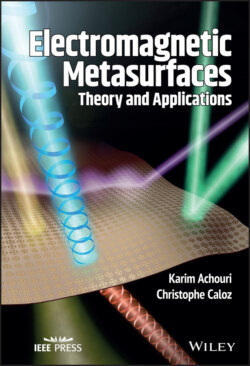Читать книгу Electromagnetic Metasurfaces - Christophe Caloz - Страница 16
2.2.2 Lorentz Oscillator Model
ОглавлениеThe Lorentz oscillator is a simple classical atomic model that describes the interaction of a time-harmonic field with matter. It was initially developed to describe the resonant behavior of an electron cloud. This model has been widely used to describe the temporal-frequency dispersive nature of materials and their related frequency-dependent refractive index [140]. It turns out to be also particularly useful in describing the responses of metamaterials, as they are generally made of resonant scattering particles.
Let us consider that an electron cloud is subjected to the Lorentz electric force,
(2.15)
where is the electric charge and is the local field.4 We assume here that the magnetic force is negligible compared to the electric force, which is the case for nonrelativistic velocities, and that the nuclei, which are much heavier than the electrons, are not moving. The restoring force between the nuclei and the electrons can be expressed similarly to the force of a mass attached to a spring, i.e.
(2.16)
where is the mass of the electron cloud, is a constant analogous to the stiffness of the spring, and is the displacement from equilibrium of the electron cloud. Finally, to model dissipation, we introduce the frictional force
(2.17)
where is the displacement velocity of the electron cloud and is a constant representing the friction coefficient. Applying Newton's second law with these three forces, we obtain
(2.18)
Rearranging the terms and noting that , we get
(2.19)
This equation may be written in a more convenient form by noting that the displacement from equilibrium is related to the electric polarization density as [140], where is the electron density. This transforms (2.19) into
(2.20)
For electrically small particles, we may use the Clausius–Mosotti expression, which relates the local field to the total electric, and to the polarization density as [140], which reduces (2.20) into
(2.21)
where is the resonant frequency. In the harmonic regime, this equation becomes
(2.22)
where is the time-domain Fourier transform of and that of . Finally substituting , eliminating , and solving for yields the dispersive susceptibility
(2.23)
where is the plasma frequency. Equation (2.23) is referred to as the Lorentz model and its frequency dependence is plotted in Figure 2.2. Note that the susceptibility (2.23) is a complex quantity that naturally satisfies Kramers–Kronig relations (Eqs. (2.13) and (2.14)).
An important particular case of the Lorentz model (2.23) is the Drude model, which applies to metals. In a metal, the electrons are free charge carriers, which implies that the restoring force (2.16) is zero, leading to in (2.23). The Drude model is particularly useful for modeling metals in the optical regime, where the frequency of light approaches the plasma frequency.
The plasma frequency and damping of aluminum, gold, and silver, which are metals frequently used in the optical regime, are reported in Table 2.1. As the frequency increases and approaches the plasma frequency, these metals behave more and more as lossy dielectrics. In contrast, in the microwave regime, metals behave as perfect electric conductors (PEC), with negligible dispersion. This is of particular importance for the practical realization of metallic-based metasurfaces, especially in the optical regime where the lossy nature of these metals becomes substantial.
To further illustrate the dispersive behavior of these metals, Figure 2.3 plots the real and imaginary parts of their permittivity in the optical regime. At the longer wavelengths, they behave as expected, i.e. they exhibit a permittivity with large negative real and imaginary parts. However, as the wavelength tends toward the plasma frequency, their optical behavior changes: they become less opaque and thus let light penetrate deeper in them.
Figure 2.2 Dispersive response of the electric susceptibility of a resonant structure for the parameter (Eq. (2.23)).
Table 2.1 Plasma frequency (corresponding wavelength) and damping for three common metals [116].
| Metal | Plasma frequency, (eV) | Damping, (eV) |
|---|---|---|
| Ag | 9.013 (137.56 nm) | 0.018 |
| Au | 9.026 (137.36 nm) | 0.0267 |
| Al | 14.75 (84.06 nm) | 0.0818 |
